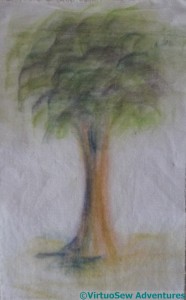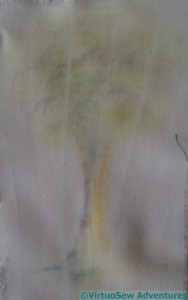Thinking about The Conversion Of Placidus
I still believe there is a lot to do for the Dreams of Amarna, but at the same time, when I have moments when I know what I am doing and have brain power to spare, I am thinking about the Conversion of Placidus panel that I’d like to do, inspired by Elizabeth Goudge, Pisanello, and La dame a la licorne.
In fact I’ve already bought some calico for the base layer and I’m wondering how to get the design onto it in a reasonably stable but not intrusive fashion. Inktense blocks have been suggested, and when I bought some I was told that once the pigment has been washed over with water, it becomes permanent.
So I found a scrap of cotton and sketched a rather cotton-wool-ball-on-a-stick sort of tree on it, using all of the colours in my selection.
Then I painted over it with water, allowed it to dry, and ironed half of the picture.
Then the scrap went into the washing machine. I’m not expecting to do this to Placidus, by the way. It’s just that I assumed that the abrasion would be a good challenge even if the detergent wasn’t, and it will certainly be subject to abrasion when I’m making it!
As you can see, the ironing made no difference at all!
A lot of the colour has gone, but I think this is in fact enough for my purposes. Most of the panel will be applied to the calico, one way or another, so however I get the design onto the calico, it will only be a sketch map to keep me on the right track.
I do know about textile medium, by the way, but my supplier of the Inktense didn’t have any!



aloe gel works just as well as textile medium and you can find that in the drug section of most supermarkets. the water tends to give less control of the color migrating all over the place. i use water when i want a watercolor effect but mostly use the aloe gel for more control.
Hi Rachel, I don’t really know much about painting fabric! I wash calico and paint it with acrylic paint, slightly diluted, then allow the fabric to dry until just damp, then iron it between sheets of baking powder, then stitch it. This is obviously different to your method, and I’m not sure why you half ironed it. Did your process do what it was meant to? Perhaps you can point me in the best direction to read up about it?
I hope you have had a lovely Christmas and wish you all best for the New Year.
Hugs! Barbara xx
Sorry, that predictive text is a pest! That should be “between sheets of baking parchment”!
Barbara xx
I’ve been using Inktense pencils for colouring ink drawings, and I get on very well with them on paper. As you’ve found out, a lot of the colour washes away when you use them on fabric, just leaving the dye behind. The result is a bit pale, but it makes a very nice background for stitching. Presumably you could re-colour any bits you need to be darker with a second (or third) painting and washing. I haven’t yet tried aloe vera gel, although I had heard it was a good fabric medium with Inktense. I have some in the bathroom (Holland and Barrett sell it), but so far I’ve only used it on me!
Wow, that’s so interesting to see what happened. This is going to be quite a project, and I’ll be interested in seeing what happens as you go along.
I love seeing your experimental experience. Very interesting results. I’ve never done much of this sort of thing so I’m learning through you.
I’m really glad you posted about your experiments and discoveries about my favourite medium for fabric Rachel! I use both blocks and pencils extensively, and love them.
Can I add to the comments with what I’ve found over the years?
Although Inktense is ink 🙂 and therefore can be used for fabric, it really only works in a decorative sense. I suggest in workshops that participants think of it in the same way that an ink stain on clothing would partially come out in the wash! It should cope with gentle sponging/hand washing, but, is not not able to resist the strength of detergent and a washing machine combined, although this can create lovely muted effects, as you have found!
Regarding paining detailed elements – I’ve found aloe vera gel works quite well as a fabric medium, but – it depends on the amount of detail required, as it’s quite clumpy. I’d suggest using a cheapie acrylic craft paint textile medium, the consistency of thinned cream. The more expensive, artist mediums are much thicker, and again can be more clumpy and often require thinning down with water.
I hope this is helpful to some one!
I like the results and I like the original! Lovely work.
I have used Inkense pencils before but then I set the dye with heat and have never wash any of my pieces. I love that washed out look. Great to embroider over.
”brain power to spare”…..love it…